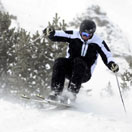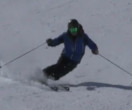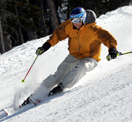I believe I read a comment that you cannot tip very much if you have tension in the hips.
Once the tension is released and greater tipping occurs, hip drop further toward the hill. At what key point do you realize you have gone from relaxing and having the hip toward the hill versus you have dropped the hip down and into the hill and may even be bending too much at the waist?
SO, I guess the question is, once I have relieved the tension, started tipping more, and the hip starts to move toward the uphill flexing leg, what keeps you from dropping the hip too far down and even bending too much at the waist?
Tipping and hips
42 posts
• Page 1 of 3 • 1, 2, 3
Re: Tipping and hips
This is the type of thing where video analysis is a big help.
-

Max_501 - Posts: 4124
- Joined: Thu Mar 10, 2005 7:39 pm
Re: Tipping and hips
davidpjr wrote:I believe I read a comment that you cannot tip very much if you have tension in the hips.
Once the tension is released and greater tipping occurs, hip drop further toward the hill. At what key point do you realize you have gone from relaxing and having the hip toward the hill versus you have dropped the hip down and into the hill and may even be bending too much at the waist?
SO, I guess the question is, once I have relieved the tension, started tipping more, and the hip starts to move toward the uphill flexing leg, what keeps you from dropping the hip too far down and even bending too much at the waist?
I'm am the King of dumping the hip
The canonical dumped hip park and ride occurs when counter-acting is performed incorrectly. When you CA, it is important to realize that you are moving two things semi-independently: your hips and your torso. With correct CA, your torso will twist farther towards the outside of the turn than your hips. If you do the dry-land hip-o-meter drill, notice your position when you reach back and touch the end of the hip-o-meter with your outside hand while you are in a tipped and countered position. What you should see is that your torso has twisted farther than your hips. Alternatively (or in addition) try tipping and then putting your hand on your outside hip and guiding it back to a countered position. I'm using the word guide, because there is going to be a range that feels natural. That is the correct hip position for CA. Now push beyond that and crank your hips as far as they will go. Notice how in order to do this, you outside leg had to straighten, and your femurs had to turn towards the outside of the turn and lock your legs up? Notice how your butt dropped and is now leading? Try to tip from that position. You can't do it. Your only choice to increase angles is to drop your hip down further, but because your butt is hanging down, this can only put you in the back seat. Not to mention that it is a gross movement and hard to control. Once you drop the hip in as far as it can go, you have no choice but to park there and ride the rest of the turn out. More than likely, you are going to have to throw some inside leg extension to dig yourself out of the position you are in, which is just going to keep the cycle going by hosing your tipping going into the next turn and forcing you to dump your hip again.
That was the canonical case, but the keys to not dumping the hip are to ensure that you have adequate flexion on both legs throughout the turn to allow you to tip. The other key is to make sure you are doing proper CA and not turning your hips farther than is necessary to negate the femoral rotation that you get from tipping. If you do those things and focus on your feet to increase your tipping angles, you should be fine. Your hip will drop into the turn, but it will lag behind your knees so they will never be blocked from further tipping.
If you feel your butt dropping down and swinging around to lead the turn, you know you are dumping the hip. Proper tipping should look and feel like a bow (as in a bow and arrow). Your hips are the top of the bow, your knees are the middle, and your feet are the bottom. You should feel a good deal of tension on the inside hip when you are really tipped, whereas your knees should feel relaxed. When you dump the hips and swing them around, you will feel tension all the way down through your knees. Try doing both dry land & you'll see what I mean.
A couple of other comments. If anything interferes with your tipping, dumping the hip becomes increasingly likely. This means that your alignment can cause this. If you are a chronic hip dumper, get your alignment checked.
Bending at the waist is a reaction to imbalance. If your butt moves back, you have to move your torso forward to get back in balance. For me, when I don't relax, I tend to stick my butt out as part of my flexion. So the key to not getting squatty is to work on your flexion. Do you go down and back, or back and down? Be especially careful of this when doing the various boot and knee touch exercises. If going down to boot causes your butt to stick out, go to the knee instead.
If you do dump your hip, you will most likely bend at the waist as well, but bending at the waist does not mean that you are dumping your hip.
Last edited by geoffda on Wed Sep 22, 2010 12:30 pm, edited 1 time in total.
-

geoffda - Posts: 862
- Joined: Tue Mar 17, 2009 10:42 am
- Location: Copper Mountain, CO
Re: Tipping and hips
This is the type of thing where video analysis is a big help.
If Geoff doesn't mind, I can post a few frames of him parking, verses when he is doing it correctly with tipping supporting counter acting.
-

h.harb - Posts: 7047
- Joined: Sat Feb 03, 2007 2:08 pm
- Location: Dumont, Colorado
Re: Tipping and hips
h.harb wrote:If Geoff doesn't mind, I can post a few frames of him parking, verses when he is doing it correctly with tipping supporting counter acting.
By all means. That way I can pretend that my bad skiing was actually for purposes of demonstration.
-

geoffda - Posts: 862
- Joined: Tue Mar 17, 2009 10:42 am
- Location: Copper Mountain, CO
Re: Tipping and hips
Great topic. When tipping I try to think about getting my bases off the snow and on their side edges, rather than the base edges, as per Harald's book. However, I'm not getting the edge angles I'd like or put another way - 'hinging" is not happening to the degree I'd like to see. Is there a way I can use my large hips, to help my small ankles, increase my LTE and BTE edging?
- tarnaby
- Posts: 112
- Joined: Sun May 10, 2009 6:15 pm
Re: Tipping and hips
Geoff gave the answer, relaxing and bending the knees.
-

h.harb - Posts: 7047
- Joined: Sat Feb 03, 2007 2:08 pm
- Location: Dumont, Colorado
Re: Tipping and hips
Thanks Harald and Geoff. If I'm already doing that, is it possible that I'm not able to tip any further b/c of a lack of balance/strength?h.harb wrote:Geoff gave the answer, relaxing and bending the knees.
- tarnaby
- Posts: 112
- Joined: Sun May 10, 2009 6:15 pm
Re: Tipping and hips
tarnaby wrote:If I'm already doing that, is it possible that I'm not able to tip any further b/c of a lack of balance/strength?
How do you know you are doing it "enough"?
-

Max_501 - Posts: 4124
- Joined: Thu Mar 10, 2005 7:39 pm
Re: Tipping and hips
Harald has often talked to me about "the tipping point" as a place many skiers can't seem to push into and past. In this instance he is not talking abou tipping of the feet. He is talking about pushing past the mental boundaries (generally fear) that prevent all of us from going much further and deeper with a particular movement pattern. I agree with Max that odds are that you have not exhausted your range of motion and flexibility with relaxing and bending the knees (and I have no video so I could be wrong). I do know that when most people (myself included) think that they are maxing out a movement, usually when they see themselves on Video, they realize immedaitely that they have come nowhere close to doing so.
Tarnaby, get some video of yourself and answer the question for sure as to whether you have maxed out this movement. If not then be relentless about taking it past the "tipping point".
Tarnaby, get some video of yourself and answer the question for sure as to whether you have maxed out this movement. If not then be relentless about taking it past the "tipping point".
Balance: Essential in skiing and in life!
-

jbotti - Posts: 2187
- Joined: Fri Nov 28, 2003 10:05 am
Re: Tipping and hips
Thanks guys. The reason I perceive myself as maxed out on the tipping side of things is b/c when I tip further than where I'm at right now, I end up having my weight on the inside ski. Put another way, I can increase my tipping angles but then I have to abandon my CB and end up banking. I'm also finding that I don't leave 2 perfect tracks in the snow but rather 2 tracks that are each widened by about a ski width.
- tarnaby
- Posts: 112
- Joined: Sun May 10, 2009 6:15 pm
Re: Tipping and hips
tarnaby wrote:Thanks guys. The reason I perceive myself as maxed out on the tipping side of things is b/c when I tip further than where I'm at right now, I end up having my weight on the inside ski. Put another way, I can increase my tipping angles but then I have to abandon my CB and end up banking. I'm also finding that I don't leave 2 perfect tracks in the snow but rather 2 tracks that are each widened by about a ski width.
Try a wall lean and then flex yourself down to the floor & you'll understand that you aren't really maxed out. Also note how much counterbalance the wall is providing
At some point, excellent counter-balancing skills are going to be required for you to tip further, or else you will end up inside. Also, when you start generating big angles, the forces get bigger and you need to be stacked skeletally to handle them. So counter-acting becomes important. And for optimum CB/CA, your poles had better being doing the right thing. Are you seeing the pattern? Besides tipping, every other movement identified by PMTS either helps make tipping possible or helps make it better. Not only do you need to practice tipping, but you need to learn to identify where weaknesses in your other movements are holding your tipping back and work on those.
-

geoffda - Posts: 862
- Joined: Tue Mar 17, 2009 10:42 am
- Location: Copper Mountain, CO
Here is the photo comparo I promised
Here is the comparison I promised. This compares staying flexed while tipping in the "High C". Extension only contributes to dumping the hip inside and therefore locked for the rest of the arc.
If you don't have time to read the text in the video, pause the video.
-

h.harb - Posts: 7047
- Joined: Sat Feb 03, 2007 2:08 pm
- Location: Dumont, Colorado
Re: Tipping and hips
Here is a supporting video for the above post.
-

h.harb - Posts: 7047
- Joined: Sat Feb 03, 2007 2:08 pm
- Location: Dumont, Colorado
Re: Tipping and hips
Harald-really helpful to see these frame-by-frame.
"I can't dance and I can't fly-but when I ski I can sometimes do both!"
Author Unknown
Author Unknown
- patprof
- Posts: 198
- Joined: Tue Feb 03, 2004 7:47 pm
- Location: Homer, New York
42 posts
• Page 1 of 3 • 1, 2, 3
Return to Primary Movements Teaching System
Who is online
Users browsing this forum: No registered users and 23 guests
